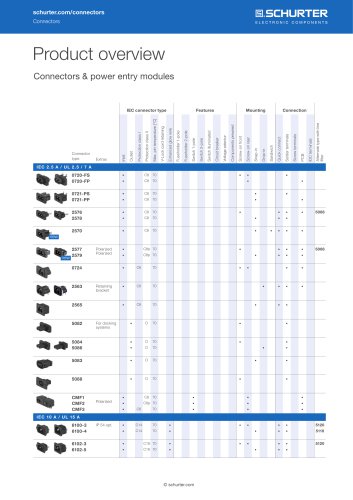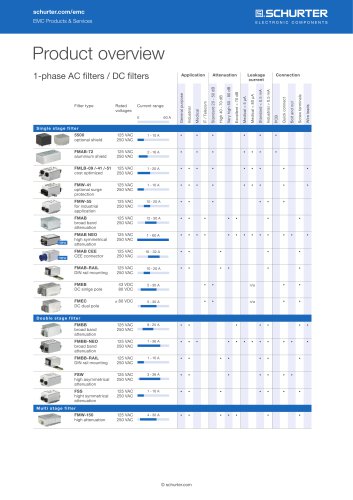 Website:
SCHURTER
Website:
SCHURTER
Group: SCHURTER
Catalog excerpts

Aerospace fuses Success story Development of aerospace fuses SCHURTER and ESA cooperation Many years of intensive cooperation in research and development between SCHURTER and the European Space Agency (ESA) has led to the incorporation of new technologies and products for protecting electronic modules in aerospace applications. which potential variation of designs, particular the most risky as identified, were investigated. This second phase was an integral part of the cooperation and only approachable because of the positive experience from the first phase. Parallel Circuit of MGA-S Figure 1) Space Application (Source: ESA) History In 2004 SCHURTER was asked by the European Space, Research and Technology Center (ESTEC), a sub-organization of the European Space Agency (ESA), to participate in a development cooperation [1] to manufacture midget fuses for use in aerospace. During a four-year evaluation phase, first the reuire q ments and potential solutions were developed, which culminated in a generic specification for the qualification, production and delivery of fuses [2]. The subsequent research and development cooperation [5] reached its high point in the MGA-S fuse being listed as an ESAqualified product. SCHURTER documented the general requirements for an aerospace fuse in a White Paper [7]; the detailed specification [3] for the MGA-S [4] is noted in a data sheet. Since 2008 SCHURTER has produced MGA-S fuses according to the agreed upon product require ments [3]. Each individual aerospace fuse undergoes a screening test. At the same time, all measure ent values are recorded and m handed over in batch documentation along with the delivery to the customer. During requali fication processes, that take place every two years, compliance of all technical production measures is checked by the ESA using clearly defined qualification criteria. Basically a higher rated current can be achieved through the parallel circuit of selected MGA-S fuses with the same cold resistance. Products [6] that have already been qualified can be used for this purpose. Electrical and thermal analyses of this ap proach were not only designed in a theoretical model at SCHURTER, but also measured in experi ental set-ups. After extensive testing, m however, this approach has some disad vantages. This is due to the increased space requirements for the parallel circuit fuses, as well as a negative impact on the Meantime Between Failure (MTBF). Increase in the rated current using MGA-S technology Based on a specification between SCHURTER and the ESA, the rated current range of 5 A to a 15 A, with a voltage of 125 VDC at a breaking capacity of 1000 A, was increased in a further experimental set-up. The mechanical dim n e sions had to be adjusted accordingly in order to absorb the energy during the high breaking test. With regard to the assembly, the ESA expected compatibility with existing solutions being used, meaning: the solder pads of the new solution had to fit the same connection geometries of the circuit board that had been defined already for the existing product. Figure 3) HCSF design study As an alternative to the thin film technology, which uses the metal sputter process, the application of LIGA technology (stands for: lithography, electroplating, and molding pro cess steps) on established substrate materials of the circuit board industry was also tested during the evaluation phase. The advantages and disadvantages during the evaluation focused on the reliability and long-term stability factors. For example, the carbon compounds generated during combustion were assessed as not sufficiently reliable because of their undefined conductance value. Accordingly, various models to simulate the change in the cold resistance, the drop in voltage and the change in the temperaturedependent current/time characteristics were developed here for the different potential de signs. These models were verified using manufactured and measured prototypes. Further development of the technical approaches Parallel to the series production of the MGA-S, a second phase of the cooperation between SCHURTER and the ESA was started in 2010, in which a solution for the protection of rated currents up to 15 A was to be developed. To this end, an evaluation phase began during This led to a solution using thin film technology, whereby a so-called sputter applies a metal layer of an exactly defined thickness in the micron range to a glass substrate material. Similar to the MGA-S, the device protecting the line is enclosed by a ceramic housing (Figure 2), which guarantees the stability necessary for the corresponding operational scenarios in the Too important to fail range. Detail specification of the high current fuse for aerospace applications Figure 2) Size comparison of the new fuse with that of the existing product Circuit Protection The evaluation of the tested approaches carried out jointly with the ESA has shown that the technical solution for the MGA-S also corresponds to that of the future high current fuse for aerospace applications, in
Open the catalog to page 1
Aerospace Fuses Success Story SCHURTER aims now to have the HCSF fuse qualified according to the ESA/ESCC 2015 listing requirements, and then proceed to series production with the recently developed product, same as its successor MGA-S. MGA-S. With the MGA-S solutions for circuit protection, and the new HCSF solution, systems comprised of several modules can also be protected. For example, redundantly designed communication systems can be protected completely with SCHURTER fuses. Conclusion: a qualified supplier of high-tech solutions The cooperation between the ESA and SCHURTER has created...
Open the catalog to page 2All SCHURTER catalogs and technical brochures
-
FMAD NEO
6 Pages
-
SUSTAINABILITY REPORT 2022
37 Pages
-
THS
5 Pages
-
TTS
4 Pages
-
Product News
4 Pages
-
FMAB NEO
12 Pages
-
FPG1
4 Pages
-
FMAB HV
6 Pages
-
UMT-W
4 Pages
-
OGN
3 Pages
-
0712
3 Pages
-
CPS
7 Pages
-
DG12
10 Pages
-
4751
4 Pages
-
FMAD CP
4 Pages
-
4783
4 Pages
-
EF11
8 Pages
-
PFRY
4 Pages
-
PFRA
6 Pages
-
PFMF
4 Pages
-
PFHT
3 Pages
-
PFDF
3 Pages
-
Company Profile
20 Pages
-
Voltage Selector
1 Pages
-
Resettable Fuses
1 Pages
-
6051.2067
3 Pages
-
6051.2068
3 Pages
-
Suppression Chokes DKIH-1
6 Pages
-
4797-5
4 Pages
-
6051.2063
3 Pages
-
6051.2061
3 Pages
-
6051.2015
3 Pages
-
3-108-993
2 Pages
-
3-100-361
3 Pages
-
GP21
3 Pages
-
AURORA Complete Solutions
2 Pages
-
FMER SOL
10 Pages
-
CMF2, CMF5
3 Pages
-
CDS1
5 Pages
-
DKIH-3
6 Pages
-
4710-5
5 Pages
-
Touchkit
3 Pages
-
USN 1206
3 Pages
-
FPBB RAIL
7 Pages
-
DD14
8 Pages
-
VAC19KS
3 Pages
-
UMK 250
4 Pages
-
TA35 Rocker 1Pole
6 Pages
-
4761
3 Pages
-
4732
4 Pages
-
FUS
3 Pages
-
DKIH
6 Pages
-
FSO
2 Pages
-
CSO
3 Pages
-
CMF1, CMF4
3 Pages
-
FMAC NEO
5 Pages
-
MSM DP 30
8 Pages
-
PSE AE 16
3 Pages
-
MSM LA CS 22
7 Pages
-
MSM LA CS 19
6 Pages
-
PSE AE 30
5 Pages
-
PSE EX 16
5 Pages
-
PSE EX 19
5 Pages
-
PSE NO 19
6 Pages
-
PSE NO 16
6 Pages
-
PSE EX 22
5 Pages
-
PSE NO 27
6 Pages
-
PSE NO 24
6 Pages
-
PSE NO 22
8 Pages
-
PSE IV 16
6 Pages
-
PSE HI 22
6 Pages
-
PSE NO 30
7 Pages
-
PSE M22 IV
7 Pages
-
MCS ES 18
3 Pages
-
MCS ES 22
3 Pages
-
6051.2094
3 Pages
-
6051.2093
3 Pages
-
6051.2078
3 Pages
-
6051.2077
3 Pages
-
6051.2070
3 Pages
-
6051.2072
3 Pages
-
6051.2071
3 Pages
-
6051.2037
2 Pages
-
6051.2030
3 Pages
-
6051.2032
3 Pages
-
6051.2031
3 Pages
-
6051.2027
3 Pages
-
3-107-570
2 Pages
-
3-107-569
2 Pages
-
VAC13KS
4 Pages
-
DD21
5 Pages
-
DD11
5 Pages
-
DF11
6 Pages
-
DG11
7 Pages
-
typ_6051.2016
3 Pages
-
typ_6051.2008
3 Pages
-
typ_6051.2009
3 Pages
-
typ_6051.2001
4 Pages
-
typ_6051.2007
3 Pages
-
typ_6051.2003
3 Pages
-
typ_6051.2004
3 Pages
-
typ_4762
3 Pages
-
typ_3-101-514
3 Pages
-
typ_3-101-501
3 Pages
-
typ_3-100-528
3 Pages
-
typ_3-100-734
3 Pages
-
typ_3-100-526
3 Pages
-
typ_3-100-523
3 Pages
-
typ_3-100-524
3 Pages
-
typ_3-100-527
3 Pages
-
typ_3-100-522
3 Pages
-
typ_3-100-356
3 Pages
-
typ_3-100-355
3 Pages
-
typ_3-100-354
3 Pages
-
Application Note Surge
2 Pages
-
White Paper IP Protection
2 Pages
-
SWA2
2 Pages
-
PB 1021
2 Pages
-
TM12-111
6 Pages
-
PTS
4 Pages
-
Piezo Keypads
4 Pages
-
PB 1011
2 Pages
-
FMAD CEE
3 Pages
-
White Paper Data Center
4 Pages
-
White Paper SPICE library
4 Pages
-
White Paper Cord retention
4 Pages
-
Efficient EMC Solutions
8 Pages
Archived catalogs
-
Product News
4 Pages
-
SCHURTER Company Profile
10 Pages
-
PFDF
3 Pages
-
PFHT
3 Pages
-
PFUF
3 Pages
-
SCHURTER Renewable Energies
6 Pages
-
SCHURTER Product News
4 Pages
-
DKFP
5 Pages
-
FMAD RAIL
3 Pages
-
FMAC RAIL
3 Pages
-
FMBD NEO
6 Pages
-
FMAC SINE DCL
4 Pages
-
FMAC SINE
4 Pages
-
FMAB RAIL
3 Pages
-
FMBB NEO
11 Pages
-
FMBB RAIL
3 Pages
-
5120
10 Pages
-
SMD-FTT
1 Pages
-
OMZ 125
1 Pages
-
4840.2200
2 Pages
-
6051.5003
2 Pages
-
6000.0224
2 Pages
-
6051.2030
2 Pages
-
6051.2003
2 Pages
-
FLBB
2 Pages
-
4741
2 Pages
-
P685
2 Pages
-
KE
4 Pages
-
GSF2
4 Pages
-
GSF1
5 Pages
-
Felcom 64
4 Pages
-
6135
5 Pages
-
KG-Bowdencable
4 Pages
-
KD-Bowdencable
4 Pages
-
DC21
3 Pages
-
1074
4 Pages
-
DC11
5 Pages
-
CMF3, CMF6
2 Pages
-
PFNF
3 Pages
-
ESO 10.3x38
1 Pages
-
SHT 6.3x32
1 Pages
-
Product Overview Switches
2 Pages
-
KEB2
1 Pages
-
New product: 6610
3 Pages
-
New product: UMZ 250
3 Pages
-
New product: CSO
2 Pages
-
New product: UST 1206
2 Pages
-
New product: UMF 250
3 Pages
-
New product: UMT-H
3 Pages
-
TA35 Rocker 2Pol
8 Pages
-
SCHURTER range at a glance
236 Pages
-
ASO / FSO
8 Pages
-
Flyer UMT 250 / UMZ 250
8 Pages
-
SCHURTER - Flyer MSM CS
2 Pages
-
Varistors
40 Pages
-
Flyer MGA-S
6 Pages




























































































































































































































































